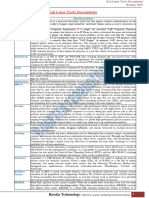0 ratings0% found this document useful (0 votes)
4 viewsSQL_Basics
Uploaded by
nasimsarker121Copyright
© © All Rights Reserved
Available Formats
Download as PDF, TXT or read online on Scribd
0 ratings0% found this document useful (0 votes)
4 viewsSQL_Basics
Uploaded by
nasimsarker121Copyright
© © All Rights Reserved
Available Formats
Download as PDF, TXT or read online on Scribd
You are on page 1/ 3
SQL Basics
1. What is SQL?
- SQL (Structured Query Language) is a standard language for managing and manipulating
relational databases.
2. Key Features of SQL:
- **Data Querying:** Retrieve data using SELECT statements.
- **Data Manipulation:** Insert, update, and delete records.
- **Data Definition:** Create, alter, and drop tables and other database objects.
- **Data Control:** Manage user access with GRANT and REVOKE.
3. Basic SQL Commands:
- **Data Query Language (DQL):**
SELECT column1, column2 FROM table_name WHERE condition;
- **Data Manipulation Language (DML):**
- INSERT INTO table_name (column1, column2) VALUES (value1, value2);
- UPDATE table_name SET column1 = value WHERE condition;
- DELETE FROM table_name WHERE condition;
- **Data Definition Language (DDL):**
- CREATE TABLE table_name (column1 datatype, column2 datatype);
- ALTER TABLE table_name ADD column_name datatype;
- DROP TABLE table_name;
4. SQL Clauses:
- **WHERE:** Filters records.
- **ORDER BY:** Sorts records.
- **GROUP BY:** Groups records based on column values.
- **HAVING:** Filters groups.
Example:
SELECT name, SUM(salary)
FROM employees
WHERE department = 'Sales'
GROUP BY name
HAVING SUM(salary) > 5000
ORDER BY SUM(salary) DESC;
5. SQL Joins:
- **INNER JOIN:** Retrieves records with matching values in both tables.
SELECT * FROM table1 INNER JOIN table2 ON table1.column = table2.column;
- **LEFT JOIN:** Retrieves all records from the left table and matching records from the right.
- **RIGHT JOIN:** Retrieves all records from the right table and matching records from the left.
- **FULL JOIN:** Retrieves all records when there is a match in either table.
6. SQL Functions:
- **Aggregate Functions:**
- COUNT(), SUM(), AVG(), MAX(), MIN()
- **String Functions:**
- CONCAT(), LENGTH(), LOWER(), UPPER(), SUBSTRING()
- **Date Functions:**
- NOW(), CURDATE(), YEAR(), MONTH(), DAY()
7. Constraints in SQL:
- **NOT NULL:** Ensures a column cannot have NULL values.
- **UNIQUE:** Ensures all values in a column are unique.
- **PRIMARY KEY:** Uniquely identifies a record in a table.
- **FOREIGN KEY:** Links two tables.
- **CHECK:** Ensures a condition is met for a column.
- **DEFAULT:** Provides a default value for a column.
8. Example Table Creation:
CREATE TABLE Employees (
ID INT PRIMARY KEY,
Name VARCHAR(50) NOT NULL,
Department VARCHAR(50),
Salary DECIMAL(10, 2) CHECK (Salary > 0)
);
9. Best Practices:
- Use meaningful table and column names.
- Normalize your database to reduce redundancy.
- Use proper indexing to improve query performance.
- Use transactions to maintain data integrity.
You might also like
- Dangerous Google - Searching For Secrets PDF88% (26)Dangerous Google - Searching For Secrets PDF12 pages
- Download ebooks file The Volatility Edge in Options Trading New Technical Strategies for Investing in Unstable Markets 1st Edition Jeff Augen all chaptersNo ratings yetDownload ebooks file The Volatility Edge in Options Trading New Technical Strategies for Investing in Unstable Markets 1st Edition Jeff Augen all chapters55 pages
- David Amos, Dan Bader, Joanna Jablonski, Fletcher Heisler Python100% (15)David Amos, Dan Bader, Joanna Jablonski, Fletcher Heisler Python643 pages
- Understanding Database Types - by Alex XuNo ratings yetUnderstanding Database Types - by Alex Xu13 pages
- Policy Document Ucc Redemption Understanding The Process Further80% (20)Policy Document Ucc Redemption Understanding The Process Further37 pages
- Dark Web Market Price Index Hacking Tools July 2018 Top10VPN291% (11)Dark Web Market Price Index Hacking Tools July 2018 Top10VPN27 pages
- Allison, Berkowitz - 2008 - SQL For Microsoft Access PDF100% (1)Allison, Berkowitz - 2008 - SQL For Microsoft Access PDF393 pages
- Learning SQL (Structured Query Language) 3No ratings yetLearning SQL (Structured Query Language) 33 pages
- Learning SQL (Structured Query Language)No ratings yetLearning SQL (Structured Query Language)3 pages
- Complete SQL Syllabus With Resources & Interview Q&A PlaylistsNo ratings yetComplete SQL Syllabus With Resources & Interview Q&A Playlists6 pages
- SQL Quick Notes in 2 Pages: Join Our Telegram Channel For More Free Resources: Follow Us On LinkedinNo ratings yetSQL Quick Notes in 2 Pages: Join Our Telegram Channel For More Free Resources: Follow Us On Linkedin2 pages
- Create Table Insert Into Select Update DeleteNo ratings yetCreate Table Insert Into Select Update Delete3 pages
- ? SQL (Beginner) - From Scratch To MasteryNo ratings yet? SQL (Beginner) - From Scratch To Mastery8 pages
- LABE MANUALOF DISTRIBUTED DATABASE SYSTEMNo ratings yetLABE MANUALOF DISTRIBUTED DATABASE SYSTEM20 pages
- Ncert Notes Class 12 Ip CH 1 Querying 2024 - 25100% (2)Ncert Notes Class 12 Ip CH 1 Querying 2024 - 252 pages
- Chapter 2 - SQL Basics and Query OptimizationNo ratings yetChapter 2 - SQL Basics and Query Optimization23 pages
- Class 12 Notes Informatices Pratice Chap 1 (2024-25)No ratings yetClass 12 Notes Informatices Pratice Chap 1 (2024-25)6 pages
- Unit-III-SQL RDBMS: A Lalitha Associate Professor Avinash Degree CollegeNo ratings yetUnit-III-SQL RDBMS: A Lalitha Associate Professor Avinash Degree College32 pages
- CLASS 11 NOTES INFORMATICS PRACTICES CHAP 8 (2024-25)No ratings yetCLASS 11 NOTES INFORMATICS PRACTICES CHAP 8 (2024-25)4 pages
- CLASS 11 NOTES INFORMATICS PRACTICES CHAP 8 (2024-25)No ratings yetCLASS 11 NOTES INFORMATICS PRACTICES CHAP 8 (2024-25)26 pages
- Postgresql Jsonb: Learn This Powerful Tool By ExampleFrom EverandPostgresql Jsonb: Learn This Powerful Tool By ExampleNo ratings yet
- Full download Network Security and Cryptography Sarhan M. Musa pdf docxNo ratings yetFull download Network Security and Cryptography Sarhan M. Musa pdf docx40 pages
- SFDSFD401 - Basics and Fundamentals of DatabaseNo ratings yetSFDSFD401 - Basics and Fundamentals of Database77 pages
- Download ebooks file Python Debugging for AI, Machine Learning, and Cloud Computing: A Pattern-Oriented Approach 1st Edition Dmitry Vostokov all chapters100% (4)Download ebooks file Python Debugging for AI, Machine Learning, and Cloud Computing: A Pattern-Oriented Approach 1st Edition Dmitry Vostokov all chapters66 pages
- (XXXX) Syllabus - Big Data Administration Training For Apache Hadoop - 280715No ratings yet(XXXX) Syllabus - Big Data Administration Training For Apache Hadoop - 2807151 page
- 2D Animation NC III (DIT Resultant) - Pre-Test - Attempt ReviewNo ratings yet2D Animation NC III (DIT Resultant) - Pre-Test - Attempt Review14 pages























































































































